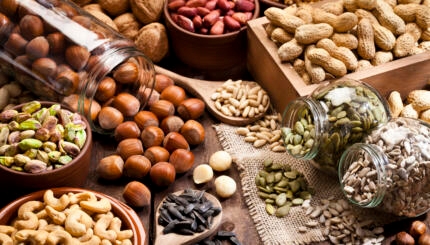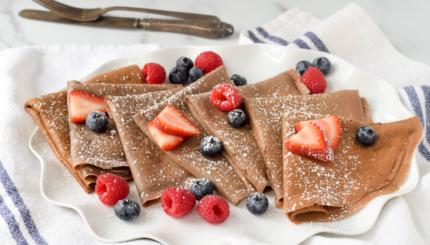Spring Quinoa with Pesto & Greens
A beautiful spring salad; perfect for your seder, for a Passover lunch, or year-round.
You might have heard rumors that there’s a grain-like food that’s for Passover. Better than a new flavor of matzah, quinoa (pronounced keen-wha) is a seed that resembles and tastes like a grain, and can be found at your local grocery store.
While it’s a relative newcomer to the American kitchen, having only been introduced to the States in the past 20 years, this ancient Andean seed has been an important food in South America for over 6000 years. A member of the goosefoot family, which is also the family of beets, swiss chard, lamb’s quarters, spinach, and amaranth, quinoa is not technically a grain, but can be used as one in cooking.Year-round, quinoa is perfect for vegans, those with celiac, and anyone looking for a change from rice. It’s gluten-free and contains all of the essential amino acids, making it a complete protein. You might be wondering why quinoa is allowed on Passover, when your favorite rice and lentils are not (if you are an Ashkenazic Jew). Ashkenazic rabbis ruled that kitniyot–products made from corn, rice, millet, and legumes–are prohibited on Passover because they are too similar to grains that are already forbidden on Passover. But quinoa didn’t make the
list, because it is a new world crop, and medieval Ashkenazic rabbis were not aware of its existence.
Furthermore, because quinoa grows in the high altitude of the Andes, where
does not grow, there is no chance of cross-contamination with the grains on the do-not-eat list. As long as quinoa is processed in a factory that does not also process grains, it’s kosher for Passover and ready for your holiday table. Some approved certifications include the Half-Moon K (KOAOA), found on the Trader Joe’s and Ancient Harvest brands of quinoa.
While there is no religious precedent against eating quinoa, there are still those that forbid it. For example, the Vaad Hakashrus of the Eida HaCharedis, a Jerusalem-based ultra-Orthodox organization opposes quinoa on Passover because they believe it is included in the kitniyot prohibition. They also express concern over the potential for cross contamination with any prohibited grains. But the companies mentioned above assure that this is not a problem, and the majority of the kosher-keeping community seems to be embracing this wholesome and satisfying Andean treat for their week without wheat.
Quinoa cooks up very easily, and is far more forgiving than rice. Each individual quinoa seed has bitter saponin covering it, to naturally repel birds and insects while the seed grows. In order to remove the bitter residue you need to wash your quinoa carefully. Simply place the quinoa in a bowl or pot, cover with water, and swish. The water will appear soapy in the bowl due to the saponoin. Pour out through a fine mesh strainer, and repeat the washing until the water runs clear. Many companies selling quinoa in the United States pre-wash their quinoa, but the box will let you know for certain if washing is necessary.
Quinoa is extremely versatile. It can be used in soups, salads, in place of rice for an entree, or even in desserts. Quinoa comes in various colors, including the most common white, but also red, green, and black. It cooks in less than 15 minutes and it’s easy to tell when it’s done because the seeds display a little white thread that curls around them.
This is a beautiful spring salad; perfect for your seder, for a Passover lunch, or year-round. The pesto turns the quinoa bright green and the red cranberries and onions stand out in texture and color.
Ingredients
1/2 cup dried cranberries
1 small red oninon, diced
1/2 teaspoon salt
2 cups water or stock
1 cup quinoa, rinsed
1 teaspoon fresh lemon juice
1/4 cup olive oil
1 teaspoon salt
1/2 cup walnuts
1 clove garlic
2 cups parsley, washed, with large stems removed
1/2 cup parsley leaves, chopped
2 teaspoons olive oil
2 teaspoons fresh lemon juice
Directions
Start by making the pesto (this can be made up to a week ahead of time). Place the parsley, garlic, walnuts, and salt in a food processor and process until smooth. Scrape down sides and turn the motor back on, drizzling in the olive oil. Add lemon juice and adjust seasoning. Set aside. If you don’t have a food processor for Passover use, you can chop everything super-fine. The salad will have a much rougher texture, but will be just as delicious.
Combine the rinsed quinoa and the water in a medium saucepan. Bring the water to a boil, reduce to low heat, cover, and cook for 12 minutes, or until the grain is translucent and the germ is opaque. If there is any extra water, drain. Set aside to cool.
In a large bowl, combine the cooked quinoa, 1/2 cup of the pesto, onions, cranberries, additional chopped parsley, olive oil, and lemon juice. Add more pesto if desired, and salt and pepper to taste. Serve at room temperature.



